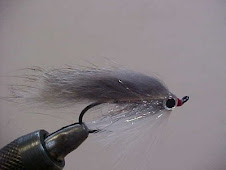

 Fly fishing Techniques: Mending your fly line
Fly fishing Techniques: Mending your fly lineby Philip Monahan
illustrations by Larry Largay
The next time you look at the surface of a river, notice that the current is not uniform from bank to bank; different parts of the river move faster or slower than others. Problems arise for fly fishermen when they have to cast a cross currents of different speeds. For instance, the current near the bank is usually slower than that in the middle of the river, so if you want to cast to the opposite bank from where you're standing, your line will lie across the faster current, while your fly sits in the slower current. Because the fast current will take your fly line downstream ahead of the fly, the line will drag the fly behind it, creating a wake and ruining the dead drift. However, if you can arrange it so the line starts upstream of the fly, the fly will float naturally for as long as it takes the fly line to catch up to and then pass the fly. This is where the basic upstream mend comes in handy.
Mending Mechanics
To achieve a good upstream mend, you've got to throw a certain portion of your line upstream of your fly. (See figure 1.) But getting your line to move up and down the river is harder than it sounds; most beginners end up dragging their flies underwater during the mend. To avoid this, you must lift the part of the fly line that you want to mend off the water, leaving the unmended portion of the line on the water. There are five keys to a good mend:
1. Mend as soon as the fly touches down, before the line has time to bond to the water's surface. This will help you avoid dragging your fly under.
2. Begin the mend with your rod tip close to the surface of the water. If you have a bunch of slack hanging from your rod tip, all you'll end up moving is the slack, not the line on the water. You may have to make a couple of quick strips to pick up this slack before you mend.
3. The hinging point, where the mended line meets the unmended line, should occur at the seam between the different speed currents. If you don't mend enough line, the current will cause the line to drag the fly; if you mend too much line, you can accidentally pull your fly out of the trout's feeding lane.
4. Lift your rod tip high, even over your head, during the mend. This will allow you to pick up more line and to avoid dragging the line across the water.
5. Mend with authority. A half-hearted mend rarely moves enough line. You'll probably over-mend the first few times — accidentally throwing your fly upstream with the line — but with some practice, you'll learn just how much power is needed to move the line you want to move without disturbing the fly.












No comments:
Post a Comment